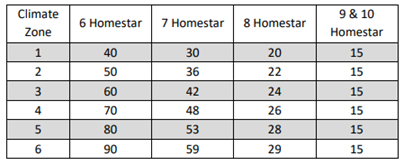11 - Homestar with Formance SIPs
Technical Bulletin #11
Created 18/08/21
Download FTB011 - Homestar with Formance SIPs
You may also be interested in...
Hear from Homeowners of Formance + Homestar home
Golden Bay community find solution to housing crisis
Are you ready for the future?- MBIE's proposed changes to the Building Code
All you need to know about air quality of a Formance home
Applicable to Homestar v5
Launched in 2009 by the New Zealand Green Building Council (NZGBC), Homestar is a rating tool that evaluates the environmental and health attributes of New Zealand homes.
Homestar ratings can be improved simply and easily by choosing the Formance system. This bulletin provides information for builders and designers using the Formance system in Homestar projects.
Homestar V5 has just been launched, the most ambitious update ever for the green home rating scheme. There are some significant upgrades compared to the previous version of Homestar, some of which are tending closer to Passive House (a world-leading standard in thermal envelope design).
Why build a Homestar house?
Building a Homestar house means that it’s easier to keep the home warm, dry, healthy, and therefore reduce impacts on the environment. Along with this, Homestar houses are more resource-efficient than code minimum houses, meaning they are more cost-effective to run. The higher Homestar rating a house gets, the more cost-effective it is to run, with annual savings on energy increasing, depending on the region and the Homestar rating.
Developers choose to build to a Homestar standard because it is a cost-effective way to lock in value throughout the building cycle[1]. The New Zealand Government Development Arm, Kãinga Ora, has committed to reaching a 6 Homestar level across all new builds. The level 6 rating is the lowest rating to be certified Homestar but still holds benefits far exceeding code minimum house projects. In addition, several banks are offering preferential mortgage rates or cash back if you can demonstrate a Homestar rating of 6 stars or higher.
How does it work?
Homestar houses are assessed and certified by qualified Homestar assessors. The Homestar process begins in the design phase or earlier, where the client should work with the assessor and architect/s to source products that will achieve the desired Homestar rating. The project should be registered with the NZGBC.
Prior to construction, the design can receive a Homestar assessment to ensure the house will be built to Homestar standards and once built, will receive the final built assessment, which the assessor prepares and submits to the NZGBC for audit. Upon a successful assessment and audit, the home will receive the Homestar rating and certification. Check the Homestar website (www.nzgbc.org.nz/homestar) for an indication of the costs involved in certification.
Who is involved in Homestar?
Homestar is governed and operated by the NZGBC, a not-for-profit organization dedicated to providing information and resources to New Zealand for the building of safe, healthy structures that have minimal impact on the environment.
NZGBC provides the training material and courses for anyone to become either a Homestar assessor, practitioner, or designer. However, only Homestar assessors can gather evidence and assess whether a home meets the Homestar standards and create a submission for the NZGBC to audit. On the NZGBC website, you can access a list of licensed Homestar practitioners and assessors available for the Homestar process.
The Points System
The Homestar rating tool is assessed on a scale of 1-100+. For a house to be a certified Homestar, it must achieve 60 or more points in the rating. There are five different levels of Homestar certification (see Figure. 1) ranging from 6 Homestar to 10 Homestar. A 6 Homestar house is easy to keep warm and healthy, more environmentally friendly than the building code and is more cost-effective to run, and a 10 Homestar house indicates a world-leading home.
Figure 1: The Homestar points system

The Winter Comfort category has the most available points out of all the Homestar categories, showing the importance of a high-performance building envelope. |
There are five main categories making up the Homestar points system.
- Efficient
- Healthy and Comfortable
- Liveable
- Environmentally Responsible
- Innovation
Each of these categories holds different weights, with “health & comfort” holding the most weight with just under 50% of the rating (for standalone homes).
These categories are further broken down into credits with the “winter comfort” credit holding 22 points, showing how much emphasis a healthy and comfortable building has in the Homestar scheme.
How can Formance help?
Within each category, credits are allocated to codes each of which have a set number of points available. Points can be collected from a range of categories, but there are mandatory minimums which must be achieved to gain a certified Homestar rating. Compared to traditional framing, points can more easily be achieved when using the Formance system in the following credits.
HC1 – Winter Comfort (22 available points)
The aim of this credit is to identify the reduction of energy used in heating and cooling of the home by improving the thermal performance of the building envelope. Formance SIPs can help toward achieving maximum points in this credit by providing high insulation and greatly improved airtightness. Success for this credit is measured in kWh/m2 per year. Different criteria apply across the 6 different climate zones and various combinations of panel thickness can help you achieve the different levels of Homestar requirements across New Zealand.

kWh/m2/ per year for the different climate zones
EF4 – Energy Use (20 available points)
The Formance system also helps gain points toward EF4, which is about the reduction of operational energy and greenhouse emissions. Measured in kWh/m2, this credit also includes the energy used by ventilation, lighting, and refrigerants, called operational energy. Success in this credit is very similar to HC1 by a strong thermal envelope providing a means for achieving the criteria.
HC4 - Moisture Control (6 available points)
The aim of this credit is to identify and encourage measures that reduce condensation in the building components reducing the risk of mould and respiratory illnesses and improving the indoor environment for the inhabitants. This credit is measured using fRsi values which defines the coldest point which can occur on the interior surface of a construction system at the junction between walls, floors, roof, and internal walls. The fRsi value achievable is often a factor of thermal bridging that occurs due to framing or other heat flow pathways. To achieve points in this credit, certain fRsi minimums must be achieved. In addition, for 8+ Homestar, the home must also be pressure tested and achieve the required maximum air leakage, measured at 50pa, m3/m2/hr.
By itself, a Formance panel is 100% free from thermal bridging. When used in construction, timber inserts are required around openings and on some construction details, which introduces a modest amount of timber thermal bridging. The overall percentage of thermal bridging however is significantly less than the same building built using traditional timber framing.
EN4 – Construction Waste (6 available points):
Homestar points are also awarded for minimizing waste in the construction process.
Being prefabricated from accurate shop drawings, the Formance system naturally reduces site waste, and this provides an opportunity to gain points under credit EN4.
Every Formance project is issued with a precise timber list that can be provided to a pre-nail frame and truss plant, allowing them to pre-cut the timber required for the project. This further minimizes site waste.
Formance panels are made at standard thicknesses of 115mm, 165mm, 215mm, 265mm and 315mm. These thicknesses have been chosen to ensure the core thickness into which timber members are fitted aligns with off-the-shelf timber sizes available from a merchant. Onsite, this translates into full optimization of materials, further minimizing site waste.
Summary
The Formance system is a straight-forward solution for parts of the Homestar scheme. By having benefits across multiple credits in the Homestar rating tool, The Formance System helps the project gain points in key credits and mandatory minimum areas such as EF4, HC1, HC4 and other minor credits.
It is recommended to provide this bulletin to your Homestar assessor as an introduction to the Formance System.
References
Alex Reiche – EnviroSpec, Homestar Certified Practitioner and Auditor www.bxg.co.nz/alex-reiche
New Zealand Green Building Council – NZGBC Website
[1] NZ Green Building Council. Why Homestar.







